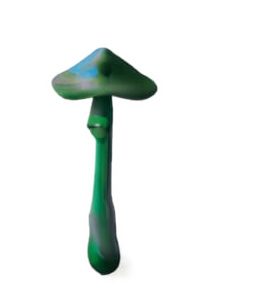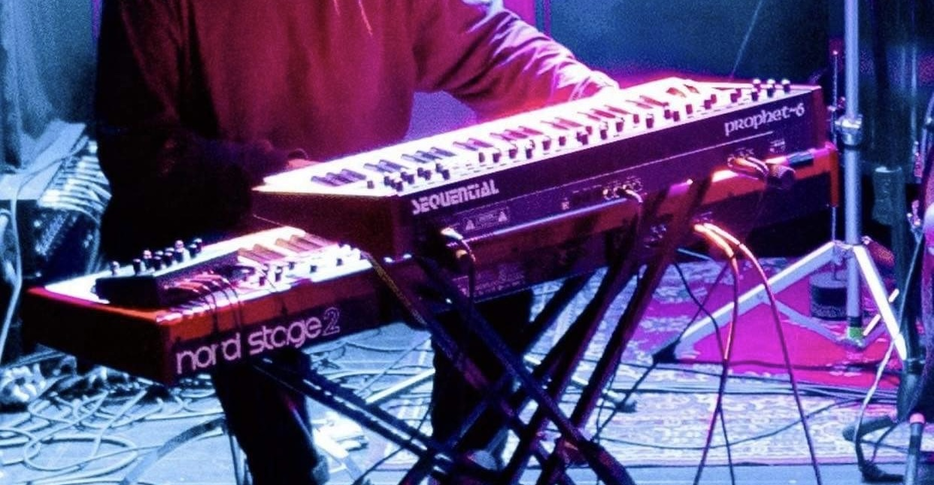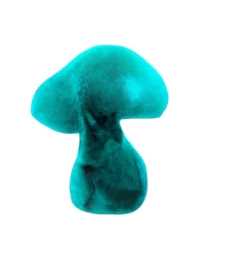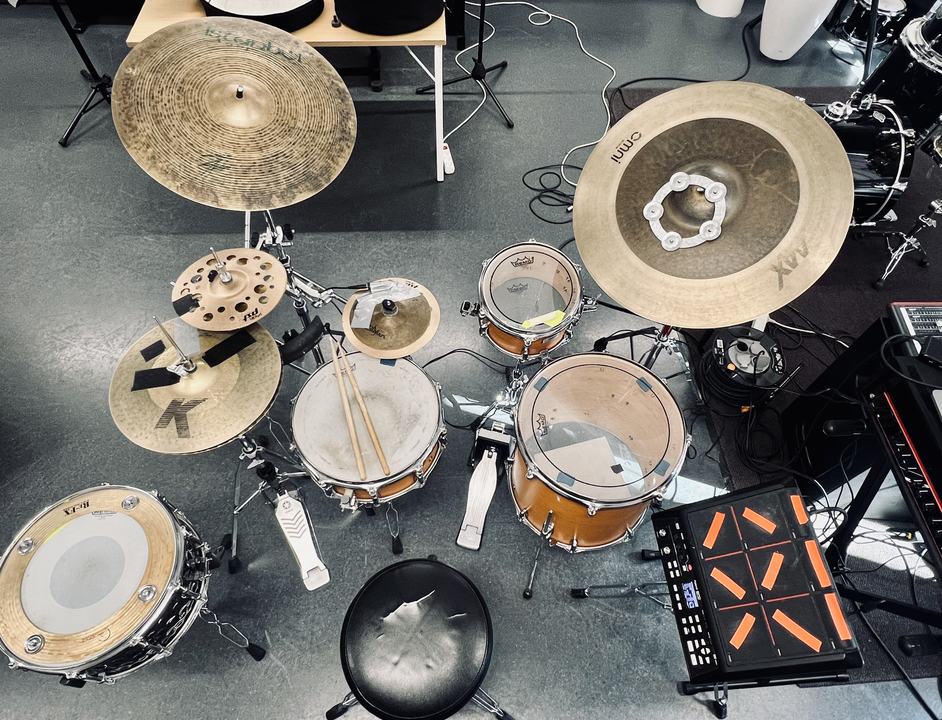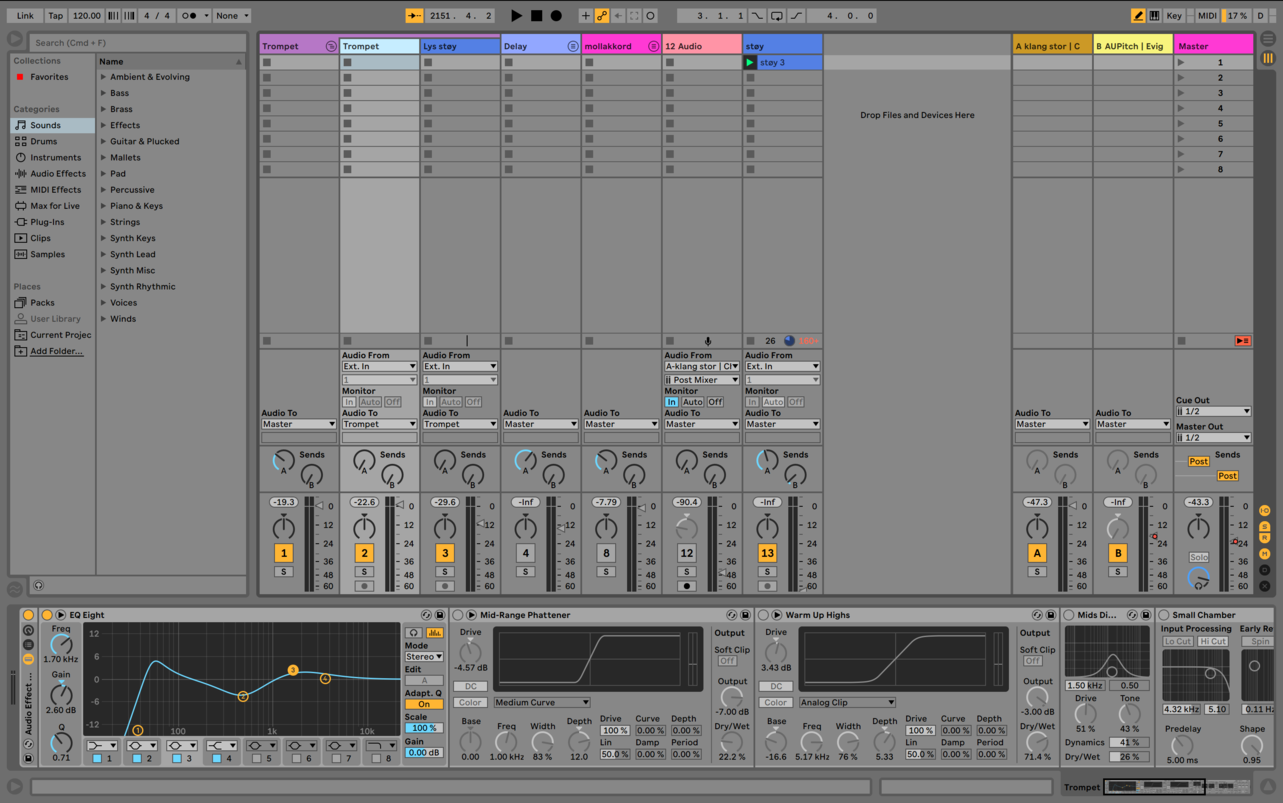Anders is responsible for the melodic lines and textures. He combines his trumpet with Ableton live to create textures and effects. His rig consists of trumpet, Ableton Live and a midi controller to controll the effect channels in Ableton.
For the trumpet playing, he focuses on being the soloists, he also tries to approach his role as being a part of the soundscape. By creating repetitive patterns and sound textures, he contributes to the overall sound of the band. In the screenshot on the right, you can see Anders' ableton rig. He has multiple channels with different effects that he swaps between with his midi controller.
Monitoring
We wanted to use in-ear monitoring rather than floor monitoring (wedges).
In the rehearsal space we used my Focusrite 18i20 for monitoring. Lines from the band were connected to the soundcard and I sent the mix through the headphone output. Then we would split the output with jack-splitter. This solution worked well in the rehearsal space, however because the cables coming from the headphone output were short, it would be impossible to use that solution on a stage. For the live performance, we decided to use Behringer P2 in-ear monitor amplifiers.
Helix Stomp is a multieffect-pedal which Noah uses to create unique sounds and variations in the soundscape of the music. All these effects have their roles in Celium. One example might be how he uses ring-modulator to create a more piercing, sharp sound that works well when we play with high intensity. Other frequently used effects are Chorus, Reverb, Distortion, Fuzz, Boost, Attack synth and Pitch Shift.
The OC-2 pedal is used a lot to create Noah’s main “synthbass” sound. He also combines the pedals to create even more complex sounds.
Because of the effect use and his role being important for the forward motion in the music, Noah focuses a lot on his right-hand technique. There are not a lot of notes played on the neck, however the patterns played with his right hand have to be clean and tight, so the driving motion does not stop.
3.3 Setup
My drum setup consists of.
-
· Roland KT-10 Kick trigger.
· Roland BT-1 Bar trigger.
· Roland SPD-SX Samplepad as a midi controller.
· 10” cymbal stack with a contact microphone taped to it (used as a midi trigger).
· MacBook Pro M1,2020 with Ableton Live 10 Suite.
· Focusrite Scarlett 18i20 Gen. 3 Soundcard.
· 12” Yamaha Tour Custom Rack tom.
· 16” Yamaha Tour Custom Floor tom.
· 14” x 5,5” Yamaha Tour Custom Snare drum.
· 14” x 6,5” Mapex “The Daisy Cutter” Snare drum.
· 14” Zildjian K Custom Hybrid HI Hats.
· 18” Istanbul Agop Signature Crash.
· 22” Sabian OMNI Ride
· 10” Paiste PSTX Swiss HI hats on auxiliary stand.
· Various percussion instruments.
Noah uses a Fender Jazz Bass guitar with both pickups on at all times. On his bass he also uses a fretwrap to avoid unnecessary noise from strings. His pedalboard consists of.
· Helix Stomp Multieffect-pedal.
· Boss OC-2 Octav-pedal.
· Empress bass compressor.
· Dunlop volume-pedal.
Here is an example of how i use the stack trigger. A contact microphone is taped to the cymbal stack, the microphone is then connected to Ableton Live. In the video you can hear combination of sample and rimshot, as well as isolated clap sound.
3.0 Celium
3.1 The overall concept
The band that is the core element of this research process was created in the fall of 2021 as a continuation of my bachelor’s degree cover project where we covered the band NERVE. Celium was created with the idea of playing house and techno music with a live band. With an open approach I decided to submit myself to the process of trying to figure out how to approach this together with my band.
The original band consists of Harsha Jerome on keys, Anders Skjerdal on trumpet, Torger Forsberg in bass, Kristian Isachsen on live sampling and live FX and me, Michal Nietyksza on drums. In the fall of 2022, we recruited Noah Kumpitak Nilsen who replaced Torger as he could not continue working with the band. Kristian Isachsen has also left the band in this period.
We started as a quintet, and at the end of the process the band consisted of four members.
In the documentary "Fantastic Fungi" (Schwartzberg, 2019),mycologist Paul Stamets explains a phenomenon called mycelium. Mycelium is a network of threads (also called hyphae) growing underground. Mycelium connects with the nature around it. In the forest, trees and plants use this network to transfer nutrients and information between each other. Mycelium connects forest life together and can be pictured as forests world wide web. It allows the life to interact.
The name Celium derives from the word mycelium which refers to this network. Celium’s goal and the overall concept is to create space where band, music and audience can co-exist, and an invisible communication can be achieved. Just like a DJ interacts with the audience and reflects their energy in his/her performance, Celium wants to interact with both music and the audience to match the performance to the atmosphere and energy of the room.
The visual profile of the band is rooted in nature and mycelium. Organic colors such as dark green, dark blue and orange can be reflected in the music. We want to transfer the audience to a forest where all life (trees, plants, animals, fungi) co-exists and the audience can feel like they are being a part of this eco-system. Aesthetics of psychedelia also play a role in the visual profile. Psychedelic colors and effects can be associated with psilocybin mushrooms (commonly known as magic mushrooms). This correlates to the music being inspired by nature and enhances the visual profile. It is a purely aesthetic choice, and it feels natural to use the psychedelic aesthetic in Celium.
Improvisation is a central element in our concept. I wanted to make room for the music to unfold itself within the framework of EDM music. Through improvisation we open for the invisible communication that may be associated with the communication in nature. By improvising and communicating with each other on stage, we want to create a sense of being one living organism and invite the audience to co-existing with us in this musical eco-system.
For the studio version we had to record without the trumpet. We played more static with less variation as we wanted to make room for Anders to record trumpet on top of the studio recording. The improvisation here was limited to the length of pre-planned parts.
After recording I sent the stems to Anders and received three trumpet takes which I chopped and mixed at my home-studio.
For the recording we incorporated samples from the original demo. The melodic theme form the demo is also played by trumpet.
3.5 Repetitive patterns
Another musical device that I knew I wanted to focus on is repetition. Repetition is something that is often associated with EDM music.
In this excerpt from a longer improvisation, we play an accumulative groove that evolves over a period of over 3 minutes.
The groove is gradually built by adding new elements and playing variation of rhythmic patterns.
1. 00:03-00:24 - A pattern in 3/4-time signature is played on rim of the snare (16 bars)
2. 00:24-00:35 Ride cymbal is added to the drum pattern (8 bars)
3. 00:35-01:31 Bass is added.
4. Pulsating synth is added. Variations in the synth pad.
5. 01:31- 02:45 Kick drum is added.
6. 02:45-03:30 Off beat hihat is added.
In this excerpt the groove builds on a gradually evolving drumbeat. The bass alternate between playing on the beat and off the beat. Keys and trumpet compliment the groove with tonal and textural variations.
3.6 Drops, breaks, tension, and release
In this chapter I would like to present some examples where we utilize elements that might be directly associated with a DJ-performance.
The idea of tension and release can be heard in this demo for a track titled “Hyphae Jive”. This idea is built on few elements.
1. Bass playing a syncopated pattern on the B-note, the note does not change until the very end. Bass does not stop.
2. Arpeggiated 16th notes with modulating filter.
3. A drumbeat that gradually builds up.
4. A trumpet playing freely on top of the band.
The groove builds up into last part preceded by a break, where the soundscape gets more and more minimalistic. After the breakdown part, chords come in, the groove builsd up and resolves in a drop that introduces progression and a new melodic hook.
Jamming on the ideas from the demo, resulted in a new drum pattern and new structure.
This version consists of four parts.
1. New drumbeat with original syncopated bassline loops itself for minute and 40 seconds.
2. Another drumbeat gets introduced. More focus on keys and textures.
3. Back to the original breakdown and drop part.
4. Outro part from the demo, without the melodic trumpet hook.
3.7 Live Performance
The artistic result of this project was a concert which took place on February 4th at Kick Scene in Kristiansand. We wanted to focus on creating a club-experience and the focus in the music was dancing. The setlist consists of eight parts.
1.Intro
2. Waves (D minor) (TID)
3. Improvisation in E minor
4. Drum n’ Bass in Ab minor
5. Free improvisation “transport stage”
6. Improvisation in G minor
7. Techno Fungi in C minor
8. Hyphae Jive (H minor)
The setlist I handed out to the band I put the musical keys, estimated tempo and initials of musicians who would initiate each section. Number 2, Waves and 8, Hyphae Jive are old tracks that we stripped down to a repetitive base groove that we improvised around. Base elements such as bass-pattern, drum groove and chords were pre-planned.
Number 5 is a section where there were no frames to work within. It was a “transport stage” and the idea is to evolve it into an improvised groove in G minor (number 6).
Number 3 and 6 are improvised sections where we agreed on which key to play in, the rest is improvised within the frameworks of House and Techno.
Number 7 was originally a fully improvised groove in C minor, however after dress rehearsal I liked what we played so much that I suggested to use the bass and groove from rehearsal and play it live.
Number 4 (Drum n bass) is the odd one out. We wanted to have a place in the set where we play in a much higher tempo. We decided to play a Drum ‘n bass groove. Drum ‘n bass as a genre generally is played in higher tempos than house and techno.
The intro is played by Harsha and Anders. It´s function is to set the atmosphere for the concert and introduce the sound of the band. Harsha and Anders were free to improvise, the only pre-planned element was the crescendo that went into the first track “Waves”.
This is Paul Berliner’s definition of improvisation. He suggests that improvisation involves some level of preparation and training, which gets spontaneously and intuitively reworked under conditions of performance (Alterhaug, 2004, p.106).
In the context of Celium, the pre-composed material and designs can be understood as the musical background of each of musicians, as well as the pre-composed material in form of demo or musical ideas we bring to rehearsal. Each of bandmembers has their own understanding of, and approach to the genre EDM. We all bring something new to the improvisational space.
From the very beginning I knew that I wanted to utilize improvisation in the music of Celium. Improvisation is something that I have been working with and exploring quite a lot in the years leading up to the creation of Celium.
While assembling the band, I based my choices on members’ familiarity with, and approach to improvisation. I was already familiar with all the members chosen for the project and had an idea as to what extent they are comfortable with improvising.
I knew that Harsha and Anders were incredible improvisators, and they improvise a lot in other projects. Kristian and I have worked with free-form improvisation in different constellations. Torger´s approach to improvisation was a bit unclear, however I knew he was a skillful bass player and that he would make a great addition to the band.
When I had to find a new bass player in 2022, the choice fell on Noah, I have heard him played before, and admired his approach to music. I also knew that he is used to improvising and worked with it on other projects.
This was important, because of my personal approach to improvised music. While performing or creating music in a rehearsal space, I prefer to rely on improvisation for creating new ideas and performing as opposed to having rigid song structures to follow or writing music from behind the desk. When working with other artists and projects, I try to place myself inside the frameworks of genre or song structure and find out to what extent I can improvise with the given material.
In the rehearsal process, we took as a starting point three different approaches to improvisation; Improvisation based on a visual description, improvisation based on a small, specific musical idea and improvisation based on a pre-composed demo. Here I present a selection of excerpts from rehearsal recordings.
In the beginning we started every rehearsal with 15-20 minutes of improvisation. These improvisational pieces/explorations were based on a visual description given by me. The descriptions were connected to themes related to mycelium and nature.
Here is an excerpt from the concert at Kick Scene, after playing a drum n bass groove, we go into a free space were there are no musical frames. We are free to play whatever we want to.
After about 70 seconds i begin to play a steady 4 on the floor pattern on the bass drum for keeping the forward motion in the music. Other than that that part is completyly improvised.
The only planned element here is that we would build up this part and transition to C minor with this heavy synth bass you can hear in this excerpt.
However, band members were also encouraged to bring ideas to the rehearsal space that we used as base for improvisation.
In this excerpt from September 27th, 2022, we play around a synth line that Harsha came up with before the rehearsal.
The last approach was to base improvisation on demos that were pre-composed by me.
Here is an example of one of the early demos I made in 2022. The title of this track is “Crackles”, and it is a rework of an older idea I created in 2020.
The structure of the demo is built in the following way.
-
1. Drum groove, a synth pad and a melodic theme played on trumpet.
2. Bass drum disappears, the drum groove gets thinner, bassline fades in.
3. Bass drum comes back, bassline continue, an extended melody I played by the trumpet and is doubled by a synth.
4. Drums disappear, trumpet and synth play freely.
5. A short drum build-up.
6. New drum groove with a clear backbeat (rimshot on 2 and 4 in the beat), new bassline, electric piano playing chords on the offbeat. (Open for solos)
In this rehearsal recording we reworked the demo and improvised based on the structure of the demo.
Here the melody in the beginning is replaced by Anders improvising with vocals and vocal processing. The last part has been extended and a new part emerged.
This second example is an excerpt from an 18-minute-long improvisation. We play in the same key as the original demo; however, the overall form of the track does not contain a lot of elements from the demo. The trumpet plays around the melodic theme and the improvisation is loosely based on the demo.
In this rehearsal recording, I play a different drum pattern.
Through jamming and discussing, we agreed on some elements that would be permanent and we would improvise around.
1. We simplified the structure.
2. New drumbeat.
3. Bitcrusher (effect pedal) on bass.
4. Added chord progression.
There is no trumpet on this recording because the trumpet player could not attend the rehearsal. It was interesting to play without the trumpet in the soundscape. Without it, we played more variations on the other instruments.
In the live version, we decided to incorporate the horn stabs from the demo. Our planned structure consisted of three parts. Improvisation on the groove with horn stabs, long breakdown part with build up and drop and the third "climax" part. During the performance, we played with adding new elements and creating tension with small breaks.
“Improvisation involves reworking pre-composed material and designs in
relation to unanticipated ideas conceived, shaped, and transformed under the special conditions of performance, thereby adding unique features to every creation (Berliner in Alterhaug, 2004, s.106).
Originally this setup was more minimalistic and did only feature cymbals, one 14” snare drum and, one floor tom and triggers. I decided to expand the setup by adding additional snare drum, rack tom and the cymbal stack trigger right above my main snare drum. I borrowed this idea from Jojo Mayer who uses a stack above his snare drum to layer sounds when playing on the rim of the snare. Unlike Mayer, I use a contact microphone taped to the cymbal-stack which is connected to Ableton live and functions as a midi trigger. For that I use a Max4Live device called Trigg.me-Audio to MIDI 1.0.
When creating the drum setup for Celium, my main goal was to combine electronic and acoustic sounds while maintain the freedom around the kit. I wanted it to feel as comfortable as possible so I could focus on being in the music. This setup gives me a wide variety of sounds and makes it easy to experiment with tonal variations when playing.
I use Roland SPD-SX samplepad as a trigger unit. Both KT-10 Kick trigger and the BT-1 are sent directly out of the SPD through two channels, this gives the sound engineer full control of both triggers. I use Ableton Live for controlling the sounds on the splash trigger as well as using a sidechain effect on the trumpet and keys. Both trumpet and keys lines go through my soundcard and out to the sound engineer. This allows me to sidechain them to my kick trigger and create a pulsating effect often used in House music.
Harsha’s keys rig consists of Nord Stage 2 Digital piano and Prophet 6 synthesizer. Together with the trumpet, Harsha is responsible for creating the foundational harmonic and melodic structures. He uses a synthesizer, digital piano, and also software-based instruments to create and manipulate sounds in real-time.
He also uses digital effects to add a unique dimension to his sounds.



